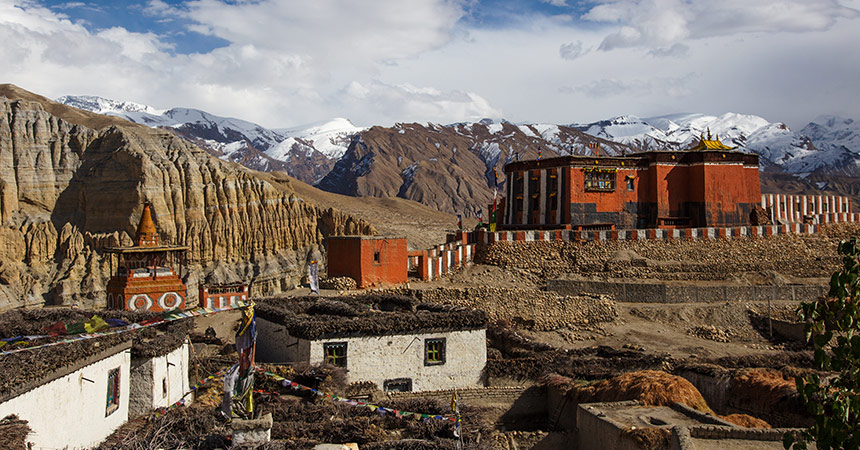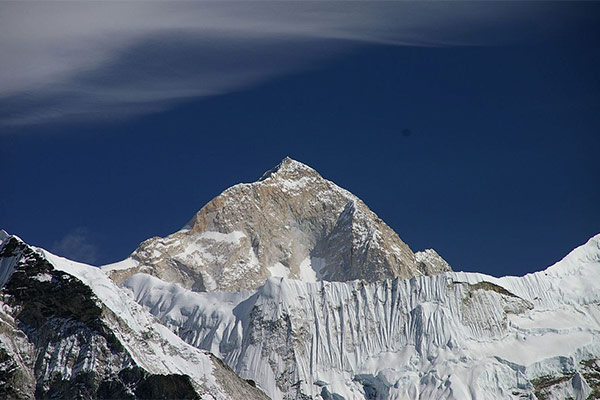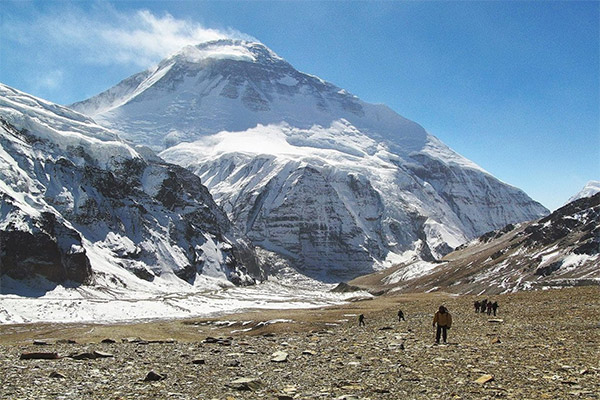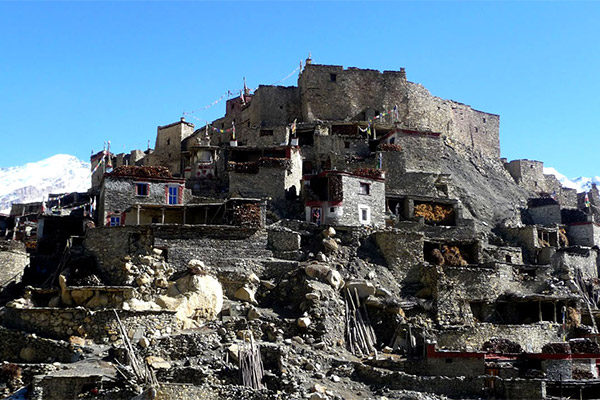- Trekking
- Expedition in Nepal
- Inbound Tours
- Outbound Tours
- About Us
- Contact us

Upper Mustang, once known as the “forbidden kingdom,” is nestled within Nepal’s restricted area. This unique region, situated in the rain shadow of the Himalayas. Upper Mustang trek offers intrepid trekkers an entrancing journey into the concealed realm of the ancient Buddhist Kingdom of Mustang. As you traverse this remarkable land, you’ll encounter an array of captivating sights. Which include ancient Gompas, sacred chortens, stupas, and fluttering prayer flags that imbue the landscape with a spiritual aura. The presence of prayer wheels, intricate mani walls, traditional villages, and enigmatic caves nestled within towering cliffs further adds to the allure of this trek.
Additionally, you will have chance to interact with the warmhearted local inhabitants. These people have steadfastly safeguarded their distinctive traditions. The way of life for generations provide you with a captivating glimpse into a cultural heritage that spans the ages. Situated on the fringes of the Himalayas, Upper Mustang shares a border with Tibet, has identical culture and arid landscape. You’ll have great views of Nilgiri, Annapurna, and Dhaulagiri and other peaks on the way up. The historical tapestry of Mustang is intricate and rich, casting a spell of fascination upon visitors.
Similarly, embarking from the tranquil city of Pokhara, your trek winds through the scenic expanse of the Kali Gandaki Valley. Along this path, you’ll traverse traditional villages nestled amidst terraced fields, gradually transitioning into the rugged landscapes of Mustang. Your first destination is the enchanting village of Kagbeni, which serves as the gateway to the realm of Upper Mustang. From here, the trail rambles deeper into Mustang’s heart, guiding you through charming settlements. The villages such as Chele, Samar, Ghami, and Tsarang ultimately lead you to the ancient capital, Lo Manthang, .
Likewise, upon exploring the marvels of Lo Manthang, your journey takes a loop. Via Yara, Tangye, Tetang, and Muktinath, ultimately bringing you to the vibrant town of Jomsom. Throughout this Upper Mustang trek, you’ll revel in the joys of trekking through serene landscapes, a testament to the unspoiled allure of Upper Mustang.
Upon your arrival in Kathmandu, you will be greeted at the airport and transferred to your hotel. Later in the evening, we will have a pre-departure meeting regarding the details of your trip.
In the morning, we will pick you up from your hotel and drive towards the beautiful city of Pokhara. The scenic drive takes us westwards, following the Prithvi Highway. During the drive, we follow Trisuli and Marshyangdi Rivers and pass many picturesque villages that dot the landscape. In the distance, Mt. Manaslu and the Annapurna Mountain ranges grace the horizon. Pokhara, the second-largest city in Nepal, welcomes us with its serene beauty and vibrant atmosphere. It is a gateway to many treks in the Annapurna region, making it a popular destination for trekkers and adventurers alike. Upon reaching at your hotel we drop your luggage and freshen up. Then we can spend rest of the day exploring the charming lakeside area of Pokhara. The Lakeside is a bustling hub filled with restaurants, shops, and cafes, all set against the backdrop of the stunning Phewa Lake. You can take a leisurely stroll along the lakeshore, enjoy the scenic views, or simply relax and take in the peaceful ambiance.
Depending on our flight time, we will depart from our hotel to take a flight to Jomsom. During 20 minutes flight, you can see beautiful landscape and Annapurna and Dhaulagir Range Mountains. After some refreshment at Jomsom, we set foot on the trail, embarking on the first day of our hiking towards Kagbeni. After crossing a wooden bridge outskirt of Jomsom town, we walk on a dirt road which lead us to a Tibetan village Kagbeni. Kagbeni is also popular among Hindu Devotees to perform after death rituals. In the evening, we will visit local monastery and temple.
Upon completing the permit registration process at the check post, we commence our trek from Kagbeni. Our trail goes along the Kali Gandaki valley ascending several ridges through barren desert-like landscape. As we proceed further, we can see vast fields stretching before us, adorned with a patchwork of buckwheat, barley, and thriving apple orchards and nestled within is Tangbe village whose stone houses are painted with red and white. After Chhusang, you can see some caves pierced in the cliffs. Then we cross a bridge over Kali Gandaki river and a steep and rocky climb up lead us to Chele.
The routes today will be bit strenuous, with numerous steep ascents and descents, but the mountain views, fascinating cave, and ancient monasteries along the way will keep us inspired. The trail climbs steeply to Taklam La at 3624 meters and arrive Samar. Afterward, the trail leads us to the quaint village of Samar, where we’ll pause to replenish our energy with a satisfying lunch. With renewed vigor, we continue our trek, embarking on a captivating journey through a vast gorge that beckons us onward. Along the way, the Rangchuyung Chorten makes its appearance, adorned in vibrant hues of red, black, yellow, and white. Continuing forward, the path leads us with a series of short ascents and descents before arriving Syanboche village.
Embarking on our trek, we start with an ascent towards another prominent pass, the Yamda La Pass (3,845m), traversing through a captivating desert like landscape and a handful of remote settlements. As we ascend we are rewarded with the majestic mountain vistas and the awe-inspiring Kali Gandaki gorge. Further, the trail leads us to a wide barley field at Geling, following an ascent through a large valley and a subsequent descent. The trail then guides us to the settlement of Tama Gaun, where we undertake a climb over the Nyi La Pass (4015 m). Descending from this pass, our trek continue forward to the village of Ghami. Nestled amidst fertile farmlands and desert-like hills, Ghami boasts a tranquil setting. Ghami houses one of the oldest monastery of Mustang. Our trek then descends to cross the Ghami river. This part of the trail can be rugged and challenging, often demanding careful navigation due to its treacherous nature. Our trek leads us past the 350 meters long mani walls, these stone-built walls are adorned with intricate carvings of Tibetan mantras. Feel free to hear the story about this mani wall from our guide. Then we reach Dhakmar village which is famous for its unique red cliffs and sky caves.
Our day’s trek begins with an early start from Dhakmar, as we set out towards the revered Lo Gekar Monastery, also known as Ghar Gompa. This ancient monastery, built in the 8th century by Guru Rinpoche, Padmasambhava, holds immense historical and spiritual significance in the Mustang region. As the founder of Tibetan Buddhism, Guru Rinpoche’s influence extends far and wide, attracting visitors from all over the world to get spiritual insight into the ancient Buddhist culture. Our trail then leads us southwest from Lo Gekar Monastery, guiding us through picturesque landscapes and charming villages such as Saukre and Marang before arriving Tsarang. Medieval fort and a Red Gompa which house a spectacular collection of statues and thangkas are the main attractions of Tsarang.
Our trek today brings us to our ultimate destination, the Lo Manthang. Todays’s trek is rather easy, with a couple of gentle uphill section. Along the trail, we traverse through a captivating landscape adorned with captivating rock formations and intricate reliefs that seem to shift in color with the changing light and weather. Our path is devoid of villages, only a 200 to 400-year-old stupa that graces the route. After around six-hour trek, the splendid city of Lo Manthang unveils itself before us. Serving as the capital of the Kingdom of Upper Mustang, walled city of Lo Manthang exudes an air of mystique and grandeur. Upon arrival, a brief respite allows us to re-energize before embarking on a captivating exploration of this historical gem. Within the palace premises, three ancient monasteries – Jampa Monastery, Thupchen Monastery, Chode Monastery stand as poignant reflections of time and devotion, inviting us to partake in their spiritual aura.
After breakfast, our day’s itinerary unfolds with a visit to Chhoser village, a journey of approximately 2.5 hours on foot from the heart of Lo Manthang. Alternatively, a horse ride can be chosen, significantly shortening the travel time to a mere hour. The attractions in the Chhoser area include centuries-old monasteries such as Garphu and Niphu (carved into the cliff), as well as colorful rock formations and centuries-old caves in rock cliffs.
Jhong cave bears a great historic importance. It is about 2500 years old. It has one entrance gate, which leads to several rooms. Once “HAJIGAVA” a Tibetan terrorist Gang attacked the village. The villagers escaped and hid themselves inside Jhong cave. The terrorist tried to enter the cave but were unable to do so, lastly they blocked the water supply. The villagers now thought of an idea. They washed their heads with mustard oil. Then the terrorist thought that the villagers had plenty of water with them. So they failed to capture the villagers and thus went empty handed. In this way, the cave provided shelter for the villagers. Beyond the intriguing cave narrative, the vantage point from this sacred site bestows a panoramic spectacle of the surrounding terrain.
We can also extend our trip to the Kora La, a Nepal-Tibet border.
Returning to Lo Manthang in the afternoon, a further treat awaits – the opportunity to explore the venerable five-storey 400-year-old royal palace.
Today we will horse ride to Ice lake nestled just 2 hours away from Lo Manthang. As we traverse this terrain on horseback, the spectacular mountain vistas and attractive rock formations we encounter make this expedition truly worthwhile.
After your arrival at Lo Manthang from the trip to Ice Lake, you can opt to rest at the hotel or go further to a small river near the city where there is salt mine. Probably you can get a glimpse into the traditional salt-mining practices of the locals.
Instead of trekking the same way back, we will make a loop to remote Yara village crossing over Dhi La Pass at 3950 m then descending to Dhi Village. Continuing ahead, we cross the Mustang Khola and walk alongside the river to Yara Village. Yara is a charming village surrounded by barren hills, rugged landscape and splendid Himalayas. Ancient caves and monasteries are other attractions of Yara Village.
Our day trip takes us to Luri Gompa near Ghara village. Luri Gompa is a cave monastery perched on a cliff wall that dates back 700 years. Luri Gumba have been preserved for generations to safeguard Buddhist history. It is adorned with ancient artifacts, intricate paintings, and sacred scriptures. Visitors can observe the monks’ daily rituals and prayers at the monastery.
As we bid farewell to Yara, our trek begins with a gentle ascend, gradually leading us amidst arid landscape and breathtaking vistas. Descending toward the meandering path of Dhechyang Khola, we continue our trip, guided by the undulating terrain. We then climb steeply to the top of a small pass before continuing on a wide plateau till we reach Tangye Village. The stark beauty of the barren Mustang landscape envelopes us, its dramatic cliffs and deep canyons casting an otherworldly spell upon the surroundings. Chortens and monasteries punctuate the panorama, imbuing the rugged terrain with a sense of sacredness and ancient wisdom. Amidst this enchanting scenery, the path leads us onward, winding its way through the enchanting rock formations to the village of Tangye. Nestled within this spellbinding realm, Tangye stands as a hidden gem, that provides a once-in-a-lifetime opportunity to see a way of life that has remained mostly untouched for decades.
Today our trek will be long and challenging. We begin our trek with an intimidating ascend from the riverbed of Tangye to the top of the cliff. Upon reaching at top, we will be welcomed by fluttering colorful player flags along with snow capped Damodar Himal and Saribung Himal. We then descend towards Pa, an abandoned settlement. Energized and determined, we resume our trek. The weird and wonderful rocks formation stand as silent witnesses to eons gone by, while the snowy visage of Dhaulagiri, Tukuche, and Nilgiri graces the vista with their majestic presence. As our descent continues, we traverse the undulating trails that lead us to Tetang.
Today is our final day of the trek. From Tetang we take a different route than we came by, which leads us mostly uphill towards Gya La Pass (4077m), which has to be crosses before entering the Muktinath Valley. From the pass we can catch stunning views of some of the highest peaks of the Himalayas, including Niligiri and Dhaulagiri as well as the beautiful Muktinath Valley and the Thorung La Pass on 5416m, which is part of the Annapurna Circuit Trek. The Gyu La Pass itself is marked by a large number of prayer flags and a couple of stone shrines. From here we continue walking downhill until reaching the Muktinath River after approximately 1 hour. From here it takes another 20 mins to reach the famous site Muktinath, a sacred place for Buddhists as well as Hindus.
In the morning we visit sacred Muktinath Temple. Eternal flame and 108 water spouts are the main attractions of this temple. Thousands of devotees visit this holy site to offer their homage. After breakfast, we drive all the way passing through scenic villages such as Kagbeni, Jomsom, Marpha, Lete before reaching Tatopani. Tatopani means “hot water” in Nepali. You can soak in a natural hot spring to relieve your aching body.
On the final day of our trip, we again drive back to Pokhara. Upon arrival at Pokhara you can explore the charming lakeside area which is a bustling hub filled with restaurants, shops, and cafes, all set against the backdrop of the stunning Phewa Lake. You can take a leisurely stroll along the lakeshore, enjoy the scenic views, or simply relax and take in the peaceful ambiance.





